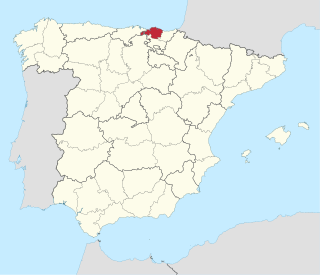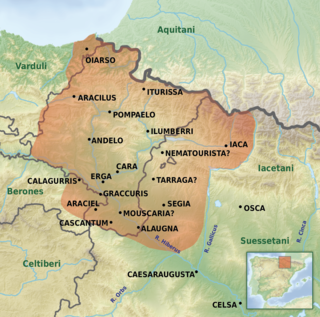History
The Varduli are mentioned for the first time during Roman times, by Strabo, who called them Bardyetai, and placed them on the Basque coast, between the Cantabri and Vascones; they are also mentioned by the geographer Ptolemy, who placed them roughly in present-day Gipuzkoa, and by Roman historians, notably Pliny the Elder in his Naturalis Historia , [6] where he reported that Amanum Portus (Roman name: Flaviobriga), present-day Castro Urdiales, was a Varduli settlement. The Roman geographer Pomponius Mela located them also on the coast, but west of the Vascones and east of the Caristii. This lack of agreement about their exact position may have been caused by the continuous movement of the tribes of the northern Iberian Peninsula during events such as the Cantabrian Wars. The first census of the Varduli population took place under the orders of Augustus. [7]
According to Pliny the Elder, [8] [9] the main Vardulian settlement was Tullonium, [8] that was in the present-day Zadorra river basin, on a main Roman road from Virovesca (capital of the Autrigones), to Pompaelo (Pamplona or Iruña) in Vasconian land. According to several authors in Classical antiquity, such as Ptolemy, Pliny the Elder and Pomponius Mela [9] other Vardulian cities were Alba and Gebala (today's Gebara), in the interior; while Tritium Tuboricum, a little west of the Deba river (Deva, Deua or Deba = Goddess), Menosca and Morogi or Morosgi, were on the Atlantic coast (on the south coast of the Bay of Biscay).
In 114 BC, Gaius Marius had a personal guard composed of Varduli people, (who were called Barduaioí) as slaves in Rome. By the year 44, according to Pomponius Mela, the Varduli inhabited lands close to the Pyrenees and composed a united society. The defeat of the Cantabri by Augustus did not have any effect on the Varduli, as they had not joined the wars. The Varduli served in cohorts in the invasion of Britannia: Varduli are mentioned in an inscription on a Roman altar at Rochester, (Roman Bremenium) and at Milecastle 19 along Hadrian's Wall, where an altar inscription made by members of the First Cohort of Varduli cavalrymen is one of the few dedications to the Matres, or mother goddesses, found in Roman Britain. The First Cohort of the Varduli are also mentioned in inscriptions at the Antonine Wall, Longovicium in Durham, Bremenium and Corstopitum in Northumberland and on the Dere Street in Cappuck in the Scottish Borders. [10]
As with the Caristii, it is not totally clear whether the Varduli were an Aquitanian tribe or a Celtized one, related to the Cantabri and Celtiberians. Some of their Toponyms were clearly of Indo-European origin (probably in the Proto-Celtic language), as Uxama (comes from Upsama, meaning "the highest"), Deobriga (comes from Deiuo-Briga, meaning "holy hill"), Tullonium (comes from Tullo, meaning "valley"), among others. Hydronyms, such as Deva (Deua or Deba for "Goddess") were also considered of Indo-European etymology. As with the Caristii, not a single toponym related to the Aquitanian-Basque languages has been found, further supporting the theory of their Celtic origin and possible late Basquisation. [2] [3] [4] However, apart from a few exceptions (Deba, Zegama , Arakama) present-day place-names show a clear prevalence of the Basque linguistic element (sometimes mixed with Latin/Romance lexical roots).
The last reference to the Varduli appears on a chronicle from Hydatius, in which he narrates the devastations that the Heruli suffered when, in the year 400, they attacked the Cantabrian coast and again in 456 after attacking Bardulia.
Ad sedes propias redeuntes, Cantabriarum et Vardaliarum loca maritima crudelissime deproedatio sunt.
— Fontes Hispaniae Antiquae, IX, p. 74
Later in the next century, Saxons established on the Bordeaux estuary also were known to raid along the coast.
Some studies theorize that the Varduli underwent a late Basquisation process, as a result of the continuous presence of the Vascones on their territory. They are mentioned again in the Early Middle Ages in the area considered to be the precursors of the modern Basque province of Gipuzkoa. Other authors [11] guessed, following Classical references, the existence of some degree of ethnic, cultural or political affinity between the Vardulii, the Caristii and the Autrigones , tribes who, later Roman sources, grouped under the name Varduli; this would explain later events in this region, for example, why, once the Caristii and Varduli were moved out of their original territories by the Vascones in the Early Middle Ages, these groups lost their names and were grouped together with the Varduli in the territory of the Autrigones. The tribes took refuge in their coastal areas behind the mountains from the Islamic military depredations of the new powers down the Ebro in Al-andalus. Eventually, after a century of resettlement, this area, along with the Meseta plains, became a frontier march or county of the Kingdom of Asturias in the middle years of the 8th century, the original core of the territory which would become Castile. The union, whatever the causes, between Varduli, Caristii and Autrigones in a single territory would later create the obscure County of Bardulia, mentioned as part of the cradle of Proto-Castile.
The coat of arms of the Basque province of Gipuzkoa reads "Fidelissima Bardulia, Nunquam Superata", [12] meaning "Most loyal Bardulia, never conquered".












